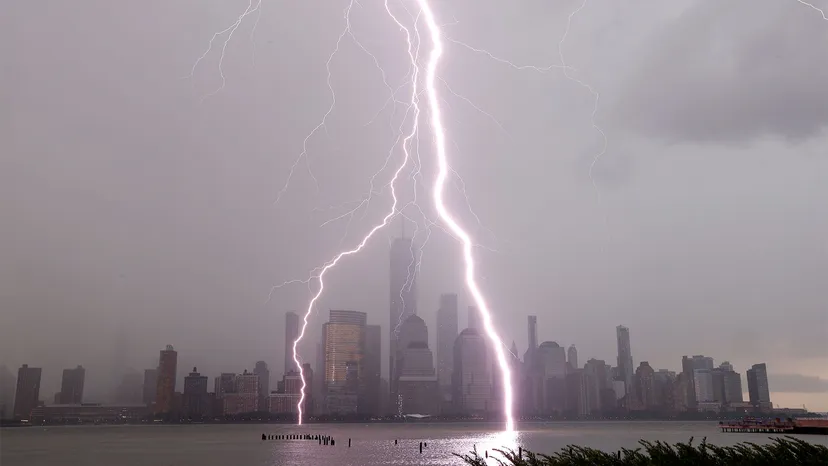We have seen in our earlier blog that ionization of air requires a high density electric field, normally achieved in nature through natural high-energy processes that provide enough energy to remove electrons from air molecules (like nitrogen and oxygen), forming ions and free electrons. Cosmic rays, UV radiation, lightening, radioactive decay, auroras, triboelectric effects (static), intense heat, Lenard effect (water), photodissociation.
Generally a balance of +ve and -ve ions in air is good. Abundant -ve ions have been shown to support health in particular situations. +ve ions generally cause oxidative stress. For those who are concerned that 5G mmWave Telco systems could possibly be ‘weaponised’ is there a possible mechanism for ionizing air with lower frequency waves (in the so called non-ionising spectrum) ?
One put forward is multi-photon excitation (similar to natural photodissociation). Technically this can indeed happen, but again in very specific circumstances which are unlikely to be present with current Telco equipment. For multi-photon excitation to ionize air it requires a very intense and high-energy light source, such as an ultra-short pulse laser. This needs specific hardware.
Multi-Photon Ionization Process
- Multi-photon ionization occurs when multiple photons are absorbed by an atom or molecule simultaneously or in very quick succession, providing enough energy to eject an electron and ionize the atom or molecule.
- In the case of air, which is mainly composed of nitrogen (N2N2) and oxygen (O2O2), ionization would mean removing electrons from these molecules, creating plasma (a mix of ions and free electrons).
Key Factors in Ionizing Air with Multi-Photon Excitation:
- Photon Energy: Each photon carries a specific amount of energy depending on its wavelength (or frequency). To ionize a molecule like nitrogen or oxygen, the total energy absorbed must exceed the ionization energy of the molecule (which is about 15.6 eV for oxygen and 14.5 eV for nitrogen).
- For example, a single photon in the ultraviolet (UV) spectrum might not have enough energy to ionize air molecules, but multiple photons (typically in the visible or near-infrared spectrum) can combine their energies to achieve this.
- Laser Intensity: The multi-photon process requires very high photon densities, which can only be achieved with extremely intense light sources, such as high-power pulsed lasers (e.g., femtosecond or picosecond lasers). The intensity needs to be sufficient for several photons to interact with the same atom or molecule at the same time.
- Number of Photons: The number of photons required for ionization depends on the wavelength of the light and the ionization energy of the gas. For example:
- If you are using photons from a visible laser (with a photon energy of about 2 eV), it might take 7 or 8 photons to ionize a nitrogen molecule (with an ionization energy of ~14.5 eV).
Air Ionization via Multi-Photon Excitation
When a high-intensity laser pulse interacts with air:
- If the photon density is high enough, several photons can be absorbed simultaneously by nitrogen or oxygen molecules.
- This results in the ejection of electrons, creating ionized particles (ions and free electrons) and forming plasma.
- The plasma can cause effects such as optical breakdown (where the medium becomes opaque due to ionization) and self-focusing of the laser beam.
This is the mechanism behind laser-induced breakdown or laser filamentation in air, where a laser pulse ionizes air along its path, creating a plasma channel that can sometimes even conduct electricity.
Practical Applications
- Multi-photon ionization of air is used in high-energy physics, plasma physics, and laser-induced plasma technologies.
- It also plays a role in applications like remote sensing, atmospheric studies, and even experiments in laser-guided lightning (where a plasma channel is used to direct electrical discharges).
In summary, multi-photon excitation can ionize air under the right conditions, primarily requiring a high-intensity laser to overcome the ionization energy of the air molecules. Do we see this hardware in small cells and 4G/5G phased array masts ?
There are other claims that particles as such do not exist, and so theories about ions and electrons are moot. We would argue however that current particle models still account for alot of what works and is observed. We can invoke new models for how nature is, but we must first see an effect to explain if the current models fall short. So far we are not aware of any data showing that air is +ve ionised to a sufficient density around a Telco mast to cause health issues.
For more on the Wave Structure of Matter – which is most likely:
https://www.spaceandmotion.com/Wolff-Wave-Structure-Matter.htm

